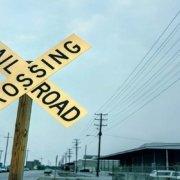Accidents Between Trains and Cars at Railroad Crossings
Alabama ranks among the top states in the nation in the number of railway incidents involving highway crossings. Why? Is it inattentiveness by drivers, speeding trains, difficult terrain blocking views or just bad luck? I performed a Google search to try to determine. Very little information. The National Safety Transportation Board issues railroad accident reports. Those reports are generally published years after a wreck. I found a website in Alabama for Alabama Operation Lifesaver. That organization has not posted any information since 2012. Here is what they reported regarding Alabama railroad crossing crashes involving motor vehicle with trains:
*apparently these were estimates as the report was issued before final tallies were in.
Nationally, it reported 1,431 crashes, 196 deaths and 760 injuries in 2011. All of those numbers are dangerously high. An Anniston Star article in May 2014 discussed several train wrecks that occurred in northeast Alabama.. Otherwise, there has been very little news in Alabama about these catastrophic wrecks – except when people die.
Locally, the stories of train collisions have been tragic.
- In 2002, a train plowed into a Ford Mustang driven by 22-year-old Jacksonville resident Tonya Lena Southward at a crossing in Choccolocco, killing her as her vehicle sat on the tracks.
- In 2010, a train struck and killed 46-year-old Oxford resident Kevin Lee McCullough as he walked down the tracks near his home around 5 a.m.
- Earlier this year, a 35-year-old Oxford woman and her 7-year-old son were killed when a car driven by the woman’s daughter was struck by an oncoming freight train in Oxford.“We have 3,500 miles of track with over 6,000 crossings,” said Nancy Hudson, executive director of Operation Lifesaver Alabama, a non-profit organization focused on railway safety.
“You’re onto something when you’re thinking about the size of the state and miles of track,” she said. “For the first time Alabama jumped into the top 15 for trespasser casualties.”
These wrecks can be prevented. Flashing lights and gates are the best warnings to keep vehicles off railroad tracks. Those are the responsibility of the railroad companies. Why aren’t there more warnings like this? Who decides what to put at these crossings? The railroad companies! That costs money and even though it has been shown in numerous settings that flashing lights and gates save lives, very few are used.
Instead of investing in those warnings, the train companies deny responsibility when one of these catastrophic car/train wrecks occur and turn to federal law to protect them from liability if they strike a car or truck. They say we took federal money to build these crossings and you cannot sue us because federal law says you can’t. This is not exactly true, but train companies have been very successful with this defense in Alabama.
We represented a passenger in a truck which was struck by a train. Due to his brain injuries, he does not remember the wreck. The truck driver stopped at the cross-buck warning and testified that because of a parked train on parallel tracks he could not see the train coming. By the time he saw the train coming it was too late. If there had been flashing lights and gates, the wreck would not have happened. We were able to overcome the use of federal money defense because the railroad was unable to prove federal funds were actually used at this particular crossing.
Even if you are as diligent as humanly possible, the wrecks can occur. They can be prevented by the use of flashing lights and gates at these intersections.




Leave a Reply
Want to join the discussion?Feel free to contribute!